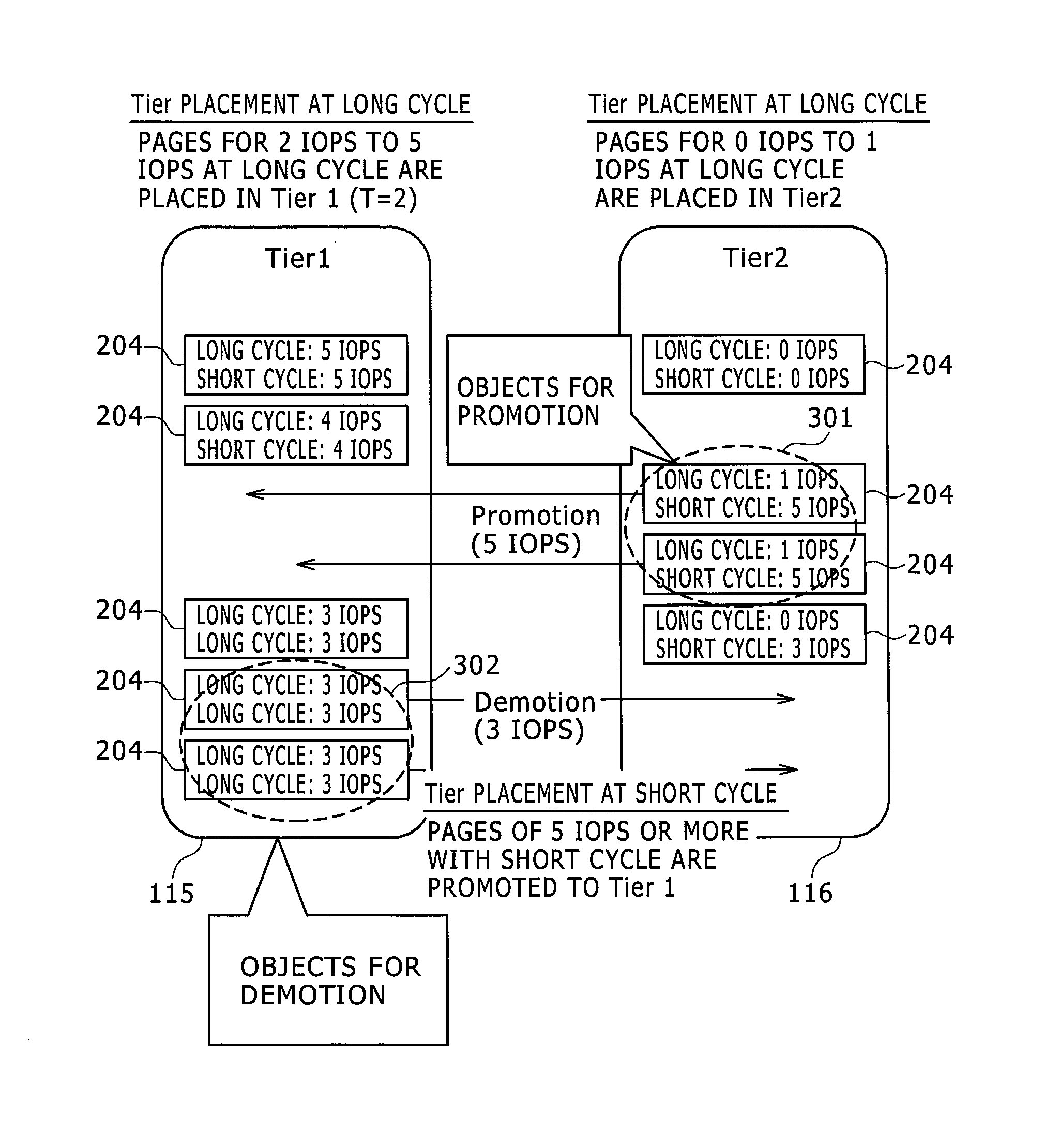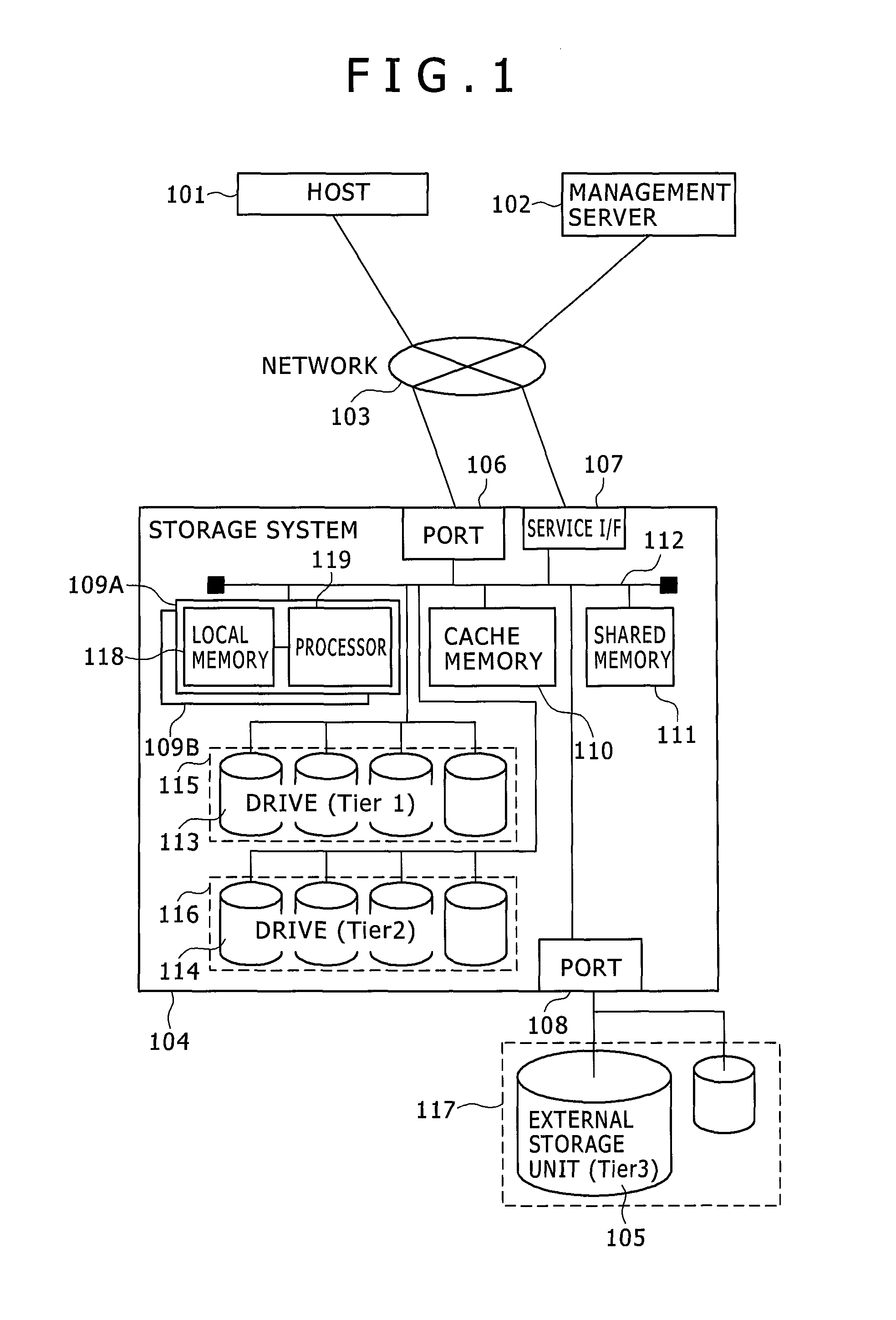Storage system
a storage system and automatic tiering technology, applied in the direction of memory adressing/allocation/relocation, input/output to record carriers, instruments, etc., can solve the problems of losing the long-cycle stable tier 1 hit rate, relocating a large quantity of pages whose load decreases, and not being able to follow up on sudden and short-cycle load shorter than the above cycle, etc., to achieve the effect of improving the data hit ra
- Summary
- Abstract
- Description
- Claims
- Application Information
AI Technical Summary
Benefits of technology
Problems solved by technology
Method used
Image
Examples
first embodiment
[0038]FIG. 1 is a block diagram showing a typical structure of the computer system of the present invention. A host 101 is for example configured from an ordinary server, and is coupled to the port 106 of the storage system 104 by way of a network 103. The host 101 issues the data read and write commands on the storage system 104, and the storage system 104 performs reading or writing of the data according to that command. The network 103 is configured for example by SAN (Storage Area Network) or Ethernet (registered trademark), etc. A management server 102 is coupled by way of the network 103 to the service I / F port 107 or port 108 of the storage system 104. The storage administrator utilizes the management server 102 to send commands for each type of setting and control required for operating the storage system to the storage system 104. If coupled to an external storage unit 105, the external storage unit 105 is coupled to the port 108 of the storage system 104. The external stor...
fourth embodiment
[0090]First of all, the monitor count-up processing starts when this (monitor rewriting & tier decision processing) starts up (S1701). More specifically, for entries in the page monitor tables corresponding to the relevant page, the long-cycle IO counter 902 counts up in the sampling phase of the current cycle, and the temporary counter 903 counts up. During the first IO, the current time is stored at the prior temporary counter expiry time. After the monitor count-up, when the temporary counter 903 reaches N, the short-cycle IOPS is calculated from (current time−prior temporary counter expiry time)÷N. The processing afterwards proceeds to the tier decision processing (S1703). If the temporary counter does not reach N or more, then the processing ends. In the method for calculating this short-cycle IOPS, the short cycle relative to a specific cycle will disappear if (current time−prior temporary counter expiry time) exceeds the specified cycle. Therefore, the measurement may be stop...
second embodiment
[0100]One example of the tier decision method is disclosed as the
[0101]FIG. 19 is a flowchart for expressing the operation in the tier decision processing of the present embodiment executed in S1703 in FIG. 17.
[0102]First of all, when this processing starts up, the (A) demotion judgment is executed (S1901). This decision processing decides whether or not to execute demotion processing on the relevant page as the demotion target. The details are described while referring to FIG. 20. If the result of the decision processing is that demotion is required (Y in S1902) then the page movement request is returned (S1905) and the processing ends. If the decision results are that demotion is not needed in S1902) then a (B) promotion decision is implemented (S1903). The decision processing decides whether or not the relevant page is a promotion target. The details are described while referring to FIG. 21. When the result is that promotion is required (Y in S1904), the page movement request is ...
PUM
 Login to View More
Login to View More Abstract
Description
Claims
Application Information
 Login to View More
Login to View More - R&D
- Intellectual Property
- Life Sciences
- Materials
- Tech Scout
- Unparalleled Data Quality
- Higher Quality Content
- 60% Fewer Hallucinations
Browse by: Latest US Patents, China's latest patents, Technical Efficacy Thesaurus, Application Domain, Technology Topic, Popular Technical Reports.
© 2025 PatSnap. All rights reserved.Legal|Privacy policy|Modern Slavery Act Transparency Statement|Sitemap|About US| Contact US: help@patsnap.com



